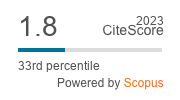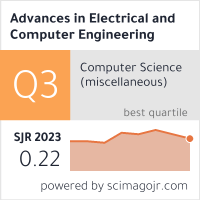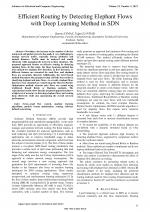| 3/2023 - 7 |
Efficient Routing by Detecting Elephant Flows with Deep Learning Method in SDNAYMAZ, S. |
| View the paper record and citations in |
| Click to see author's profile in |
| Download PDF |
Author keywords
load flow control, machine learning algorithms, particle swarm optimization, routing, software defined networking
References keywords
flow(14), networks(13), data(12), load(9), software(8), detection(8), routing(7), defined(7), balancing(7), elephant(6)
Blue keywords are present in both the references section and the paper title.
About this article
Date of Publication: 2023-08-31
Volume 23, Issue 3, Year 2023, On page(s): 57 - 66
ISSN: 1582-7445, e-ISSN: 1844-7600
Digital Object Identifier: 10.4316/AECE.2023.03007
Web of Science Accession Number: 001062641900007
SCOPUS ID: 85172349574
Abstract
Nowadays, the increase in the number of devices using local and global networks has made it very challenging to manage network traffic, especially during epidemics and natural disasters. Traffic must be analyzed and routed efficiently while managing the network in these situations. The proposed approach focuses on effective routing by detecting elephant flows. In this study, the Deep Learning method has been utilized for elephant flow detection. In flow detection, 11 different features are extracted for each flow, and elephant flows are accurately detected. Additionally, the Grid Search method determines the parameters that yield the best results in classifying elephant and mice flows. As a result, elephant flows that have been classified are routed using the Discrete-Particle Optimization method, whereas mice flows are routed using traditional Round Robin or Random methods. The experimental results show that the proposed approach achieves a high level of accuracy in detecting elephant flows and routing them effectively while also maintaining the overall network performance. |
| References | | | Cited By «-- Click to see who has cited this paper |
| [1] C. Bharanidharan, S. I. Gandhi, R. D. Devapriya, "An enhanced framework for traffic load balancing and QoS provisioning in SDN," Wireless Personal Communications, vol. 121, no. 4, pp. 3451-3472, 2021. [CrossRef] [Web of Science Times Cited 3] [SCOPUS Times Cited 4] [2] A. H. Alawadi, S. Molnar, "Oddlab: a fault-tolerant aware load-balancing framework for data center networks," Annals of Telecommunications, vol. 77, pp. 641-662, 2021. [CrossRef] [Web of Science Times Cited 2] [SCOPUS Times Cited 2] [3] D. Wang, "SDN-based load balance routing mechanism for information centric networking," Internet Technology Letters, vol. 6, no. 2, 2022. [CrossRef] [Web of Science Times Cited 1] [SCOPUS Times Cited 2] [4] S. Torkzadeh, H. Soltanizadeh, A. A. Orouji, "Energy-aware routing considering load balancing for SDN: A minimum graph-based ant colony optimization," Cluster Computing-The Journal of Networks Software Tools And Applications, vol. 24, no. 3, pp. 2293-2312, 2021. [CrossRef] [Web of Science Times Cited 19] [SCOPUS Times Cited 29] [5] R. Amin, E. Rojas, A. Aqdus, S. Ramzan, D. Casillas-Perez, J. M. Arco, "A survey on machine learning techniques for routing optimization in SDN," IEEE Access, vol. 9, pp. 104582-104611, 2021. [CrossRef] [Web of Science Times Cited 50] [SCOPUS Times Cited 67] [6] W. X. Liu, J. Cai, Q. C. Chen, Y. Wang, "DRL-R: Deep reinforcement learning approach for intelligent routing in software-defined data-center networks," Journal of Network and Computer Applications, vol. 177, pp. 102865, 2021. [CrossRef] [Web of Science Times Cited 56] [SCOPUS Times Cited 74] [7] Y. Guo, H. Luo, Z. Wang, X. Yin, J. Wu, "Routing optimization with path cardinality constraints in a hybrid SDN," Computer Communications, vol. 165, pp. 112-121, 2021. [CrossRef] [Web of Science Times Cited 12] [SCOPUS Times Cited 16] [8] A. Mondal, S. Misra, "FlowMan: QoS-Aware dynamic data flow management in software-defined networks," IEEE Journal on Selected Areas in Communications, vol. 38, no. 7, pp. 1366-1373, 2020. [CrossRef] [Web of Science Times Cited 11] [SCOPUS Times Cited 15] [9] P. Jurkiewicz, "Boundaries of flow table usage reduction algorithms based on elephant flow detection," IFIP Networking Conference (IFIP Networking), pp. 1-9, 2021. [CrossRef] [Web of Science Times Cited 9] [SCOPUS Times Cited 13] [10] Q. Tang, H. Zhang, J. Dong, L. Zhang, "Elephant flow detection mechanism in SDN-based data center networks," Hindawi Scientific Programming, vol. 2020, pp. 1-8, 2020. [CrossRef] [Web of Science Times Cited 6] [SCOPUS Times Cited 10] [11] L. X. Liao, J. Wang, H. C. E. Chao, B. Qin, "Distributed and efficient network hypervisor for SDN virtualization," Journal of Internet Technology, vol. 22, no. 3, pp. 625-636, 2021. [CrossRef] [Web of Science Times Cited 2] [SCOPUS Times Cited 2] [12] L. X. Liao, X. Ma, Z. Li, H.-C. Chao, "Dynamic flow entry timeouts based packet nonuniform sampling for elephant flow detection," International Symposium on Computer Technology and Information Science (ISCTIS), pp. 431-439, 2021. [CrossRef] [SCOPUS Times Cited 2] [13] F. L. Tang, H. T. Zhang, L. T. Yang, L. Chen, "Elephant flow detection and load-balanced routing with efficient sampling and classification," IEEE Transactions on Cloud Computing, vol. 9, no. 3, pp. 1022-1036, 2021. [CrossRef] [Web of Science Times Cited 40] [SCOPUS Times Cited 43] [14] M. Hamdan, S. Khan, A. Abdelaziz, S. Sadiah, N. Shaikh-Husin, S. Al Otaibi, C. Maple, M. N. Marsono, "DPLBAnt: Improved load balancing technique based on detection and rerouting of elephant flows in software-defined networks," Computer Communications, vol. 180, pp. 315-327, 2021. [CrossRef] [Web of Science Times Cited 11] [SCOPUS Times Cited 15] [15] H. T. Zhang, F. L. Tang, L. Barolli, "Efficient flow detection and scheduling for SDN-based big data centers," Journal of Ambient Intelligence and Humanized Computing, vol. 10, no. 5, pp. 1915-1926, 2019. [CrossRef] [Web of Science Times Cited 21] [SCOPUS Times Cited 25] [16] X. Shi, Y. Li, H. Xie, T. Yang, L. Zhang, P. Liu, H. Zhang, Z. Liang, "An openflow-based load balancing strategy in SDN," CMC-Computers Materials & Continua, vol. 62, no. 1, pp. 385-398, 2020. [CrossRef] [Web of Science Times Cited 21] [SCOPUS Times Cited 29] [17] S. Vargaftik, C. Caba, L. Schour, Y. Ben-Itzhak, "C-Share: Optical circuits sharing for software-defined data-centers," ACM Sigcomm Computer Communication Review, vol. 50, no. 1, pp. 3-9, 2020. [CrossRef] [Web of Science Times Cited 2] [SCOPUS Times Cited 2] [18] T. L. Kao, Y. T. Miao, S. Y. Wang, "OPS: a fairness link allocation based on SDN in datacentre networks," International Journal of Communication Networks and Distributed Systems, vol. 25, no. 3, pp. 307-332, 2020. [CrossRef] [SCOPUS Times Cited 2] [19] T. Benson, A. Akella, D. A. Maltz, "Network traffic characteristics of data centers in the wild," IMC '10: Internet Measurement Conference, pp. 267-280, 2010. [CrossRef] [SCOPUS Times Cited 1861] [20] T. Cavdar, S. Aymaz, "A new approach for dynamic load balancing in SDN-based data centers," ETRI Journal, 2023. [CrossRef] [Web of Science Times Cited 1] [SCOPUS Times Cited 1] [21] K. Rishabh, K. Angadi, K. Chegu, D. S. Harikrishna, S. Ramya, "Analysis of load balancing algorithm in software defined networking," 2nd International Conference on Computational Systems and Information Technology for Sustainable Solution (CSITSS), pp. 1-4, 2017. [CrossRef] [SCOPUS Times Cited 6] [22] S. Dev, B. Kumar, D. C. Dobhal, H. Singh Negi, "Performance analysis and prediction of diabetes using various machine learning algorithms," 4th International Conference on Advances in Computing, Communication Control and Networking (ICAC3N), Greater Noida, India, pp. 517-521, 2022. [CrossRef] [SCOPUS Times Cited 4] [23] M. Hamdan, B. Mohammed, U. Humayun, A. Abdelaziz, S. Khan, M. A. Ali, M. Imran, M. N. Marsono, "Flow-aware elephant flow detection for software-defined networks," IEEE Access, vol. 8, pp. 72585-72597, 2020. [CrossRef] [Web of Science Times Cited 37] [SCOPUS Times Cited 49] [24] S. C. Chao, K. C. J. Lin, M. S. Chen, "Flow classification for software-defined data centers using stream mining," IEEE Transactions on Services Computing, vol. 12, no. 1. pp. 105-116, 2019. [CrossRef] [Web of Science Times Cited 33] [SCOPUS Times Cited 45] [25] A. Pekar, A. Duque-Torres, W. K. G. Seah, O. M. C. Rendon, "Towards threshold-agnostic heavy-hitter classification," International Journal of Network Management, vol. 32, no. 3, pp. 1-22, 2022. [CrossRef] [Web of Science Times Cited 6] [SCOPUS Times Cited 6] [26] F. Estrada-Solano, O. M. Caicedo, N. L. S. Da Fonseca, "NELLY: Flow detection using incremental learning at the server side of SDN-based data centers," IEEE Transactions on Industrial Informatics, vol. 16, no. 2, pp. 1362-1372, 2020. [CrossRef] [Web of Science Times Cited 20] [SCOPUS Times Cited 20] [27] M. Mathis, J. Semke, J. Mahdavi, T. Ott, "The macroscopic behavior of the TCP congestion avoidance algorithm," ACM SIGCOMM Computer Communication Review, vol. 27, no. 3, pp. 67-82, 1997. [CrossRef] [SCOPUS Times Cited 1087] [28] B. M. Bwalya, S. Tembo, "Performance evaluation of buffer size for access networks in first generation optical networks," International Journal of Internet of Things, vol. 6, no. 3, pp. 98-105, 2017. [CrossRef] [29] K. Xi, Y. Liu, H. J. Chao, "Enabling flow-based routing control in data center networks using probe and ECMP," IEEE Conference on Computer Communications Workshops (INFOCOM WKSHPS), pp. 608-613, 2011. [CrossRef] [SCOPUS Times Cited 18] [30] M. Al-Fares, S. Radhakrishnan, B. Raghavan, N. Huang, A. Vahdat, "Hedera: Dynamic flow scheduling for data center networks," 7th USENIX conference on Networked systems design and implementation, pp. 19, 2010. [CrossRef] Web of Science® Citations for all references: 363 TCR SCOPUS® Citations for all references: 3,449 TCR Web of Science® Average Citations per reference: 12 ACR SCOPUS® Average Citations per reference: 111 ACR TCR = Total Citations for References / ACR = Average Citations per Reference We introduced in 2010 - for the first time in scientific publishing, the term "References Weight", as a quantitative indication of the quality ... Read more Citations for references updated on 2024-10-21 22:27 in 205 seconds. Note1: Web of Science® is a registered trademark of Clarivate Analytics. Note2: SCOPUS® is a registered trademark of Elsevier B.V. Disclaimer: All queries to the respective databases were made by using the DOI record of every reference (where available). Due to technical problems beyond our control, the information is not always accurate. Please use the CrossRef link to visit the respective publisher site. |
Faculty of Electrical Engineering and Computer Science
Stefan cel Mare University of Suceava, Romania
All rights reserved: Advances in Electrical and Computer Engineering is a registered trademark of the Stefan cel Mare University of Suceava. No part of this publication may be reproduced, stored in a retrieval system, photocopied, recorded or archived, without the written permission from the Editor. When authors submit their papers for publication, they agree that the copyright for their article be transferred to the Faculty of Electrical Engineering and Computer Science, Stefan cel Mare University of Suceava, Romania, if and only if the articles are accepted for publication. The copyright covers the exclusive rights to reproduce and distribute the article, including reprints and translations.
Permission for other use: The copyright owner's consent does not extend to copying for general distribution, for promotion, for creating new works, or for resale. Specific written permission must be obtained from the Editor for such copying. Direct linking to files hosted on this website is strictly prohibited.
Disclaimer: Whilst every effort is made by the publishers and editorial board to see that no inaccurate or misleading data, opinions or statements appear in this journal, they wish to make it clear that all information and opinions formulated in the articles, as well as linguistic accuracy, are the sole responsibility of the author.





